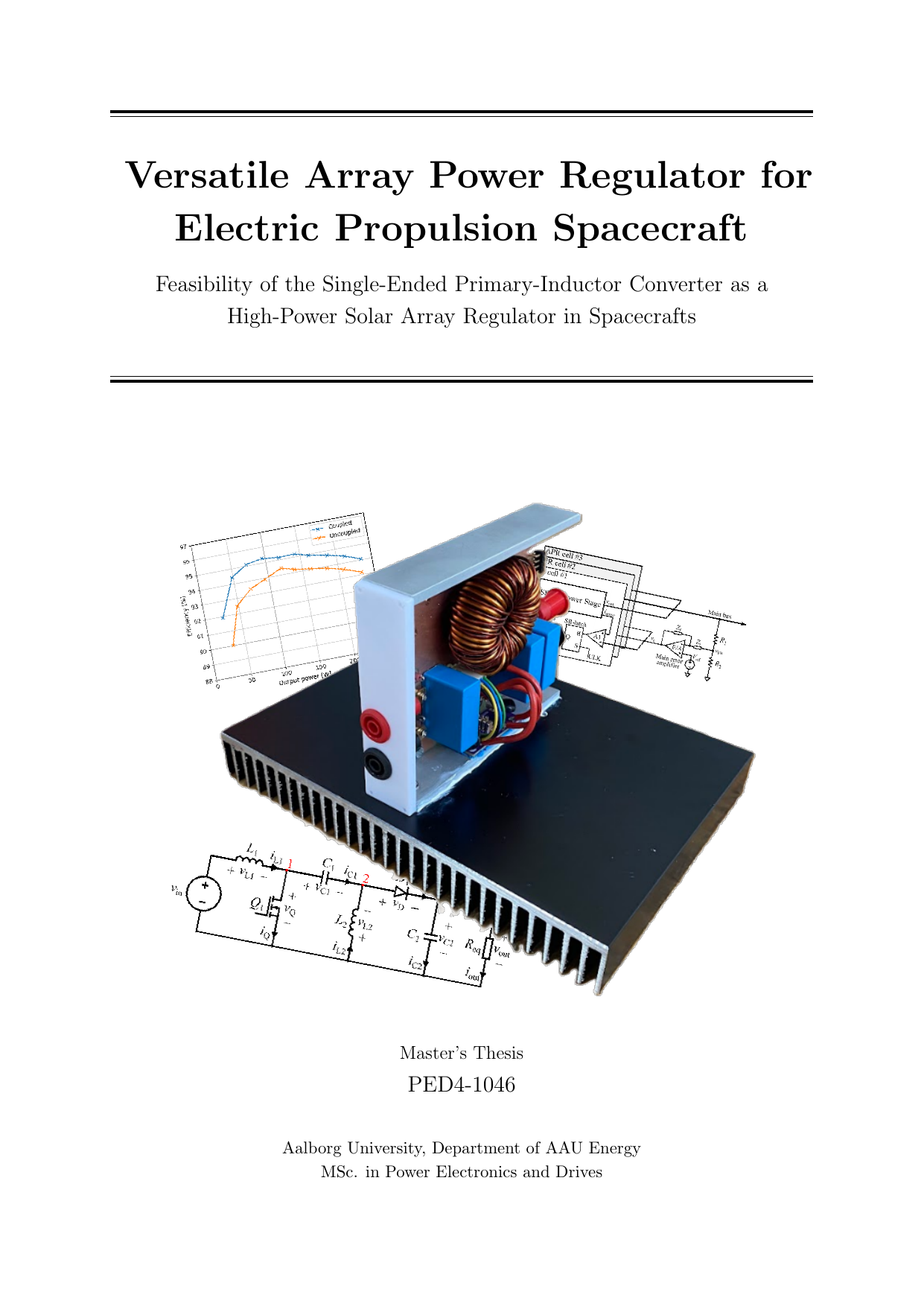
Versatile Array Power Regulator for Electric Propulsion Spacecraft: Feasibility of the Single-Ended Primary Inductor Converter as a High-Power Solar Array Regulator in Spacecrafts
Author
Term
4. term
Education
Publication year
2025
Submitted on
2025-05-27
Pages
70
Abstract
Med fremkomsten af elektrisk fremdrift (EP) stiger energibehovet for strømforsyningssystemet (EPS) i rumfartøjer. En højere spænding på solcelle-strengen (PV) medfører en øget risiko for elektrostatiske udladninger (ESD) som følge af opladning af rumfartøjet. Dette projekt omhandler derfor vurderingen af muligheden for at anvende en spændingshævende og -sænkende topologi til at holde spændingen på PV-strengen på et acceptabelt niveau. SEPIC-topologien blev valgt som den mest egnede, da den har en kontinuerlig indgangsstrøm og et ikke-inverteret udgangssignal. For at vurdere SEPIC-topologiens anvendelighed blev der udviklet en algoritme til estimering af effekttab samt en laboratorieprototype. For at minimere effekttabet blev prototypen designet med en Schottky-diode og en GaN HEMT. Algoritmen til effekttabsestimering og resultaterne fra de eksperimentelle tests viste, at SEPIC-topologien opnår en højere effektivitet, når induktorerne er koblet på samme kerne. Under laboratorietest blev der målt maksimale virkningsgrader på henholdsvis 92,2 % og 96,8 % ved koblingsfrekvenser på 500 kHz og 250 kHz. Endelig blev SEPIC-topologiens småsignaldynamik undersøgt, hvilket viste, at den indeholder højresidede nulpunkter (RHP-zeros). Ved at implementere peak current-mode kontrol og kompensere styresløjfen med en type-II kompensering blev det demonstreret, at det er muligt at opnå tilstrækkelig båndbredde med SEPIC-topologien. Gennem simuleringer i LTspice blev det bekræftet, at denne kontrolstrategi kan opfylde ECSS-standarderne for både statisk og transient regulering.
With the advent of electric propulsion the power demand of the electrical power system in spacecrafts is increasing. A higher PV string voltage results in higher risk of ESD due to spacecraft charging. Thus this project revolves around evaluating the feasibility of a step-up-and-down topology to maintain the PV string voltage at an acceptable level. The SEPIC was selected as the most suitable topology, because it has a continuous input current and a non-inverted output. To assess the feasibility of the SEPIC, a power loss estimation algorithm was developed alongside a laboratory prototype. To minimise the power losses, the prototype was developed with a Schottky diode and a GaN HEMT. The power loss estimation algorithm and results of experimental testing were used to demonstrate that the SEPIC exhibits a better efficiency when the inductors are coupled on the same core. During the laboratory testing peak efficiencies of 92.2% and 96.8% were measured for at a switching frequency of 500kHz and 250kHz, respectively. Finally the small-signal dynamics of theSEPIC were studied, revealing that the SEPIC consist of RHP zeros. By implementing peak current-mode control and compensating the control loop with a type-II compensator, it was found that it is possible to attain a sufficient bandwidth with the SEPIC. Through simulations in LTspice it was proven that this control strategy is capable of fulfilling the ECSS standards regarding static- and transient regulation.
Keywords
Documents
